|
80x5 -
240x3 -
240x4 -
320x1 -
320x2 -
320x3 -
640x1 -
640x2
Set display option above.
Click on
images to enlarge. |
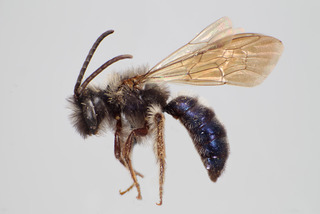
© Copyright Laurence Packer 2014
· 7
Andrena cerasifolii MALE CFP |
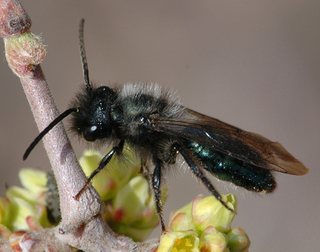
Hartmut Wisch · 1
Andrena cerasifolii |
|
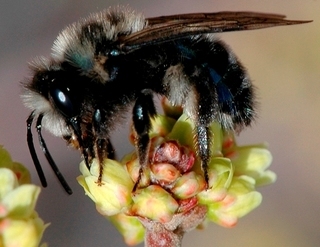
Hartmut Wisch · 1
Andrena cerasifolii |
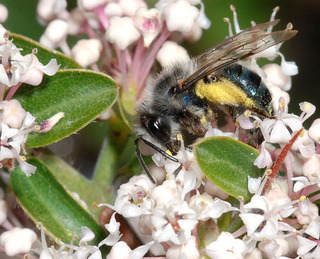
Robert A. Behrstock · 1
Andrena cerasifolii, Robert A. Behrstock |
|
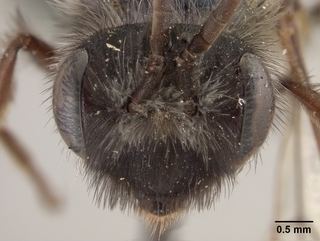
Smithsonian Institution, Entomology Department · 1
Andrena cerasifolii, face |
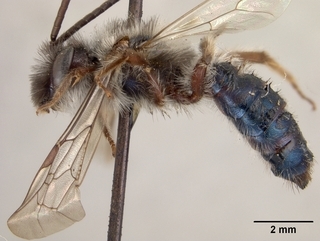
Smithsonian Institution, Entomology Department · 1
Andrena cerasifolii, side |
|
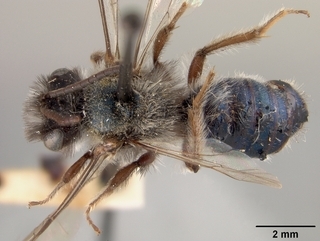
Smithsonian Institution, Entomology Department · 1
Andrena cerasifolii, top |
|
Overview |
Reprinted with permission of the American Entomological Society from:
LaBerge, W. E. 1987. A revision of the bees of the genus Andrena of the Western Hemisphere. Part XII. Subgenera Leucandrena, Ptilandrena, Scoliandrena and Melandrena. Transactions of the American Entomological Society 112: 191-248.
Please report text errors to: leah at discoverlife dot org.
Andrena cerasifolii is a dark metallic blue-black species with intensely punctate metasomal terga and a shiny galea. The male can be told from the related species described below by the short first flagellar segment which is never longer than the second segment and usually slightly shorter. The female of cerasifolii differs from its closest relative by the more intense punctation and the usually darker vestiture.
FEMALE. MEASUREMENTS AND RATIOS. — N = 20; length, 10-13 mm; width, 3-4 mm; wing length, M = 4.35 ± 0.166 mm; FL/FW, M = 0.92 ± 0.004; FOVL/FOVW, M = 2.54 ± 0.027.
INTEGUMENTAL COLOR. — Black except as follows: thorax except propodeum and metasomal terga and sterna dark metallic blue-black; mandible with apical half dark rufescent; flagella below dark brown; wing membranes hyaline, slightly infumate, veins dark brown; distitarsi dark rufescent; tibial spurs dark.
STRUCTURE. — Antennal scape length equals first three flagellar segments; flagellar segment 2 slightly broader than long and slightly shorter than 3; segments 3-9 longer than broad. Eyes each about three and three-fourths times as long as broad, inner margins parallel. Mandibles short, when closed surpassing midlabrum by no more than one-fourth mandibular length. Malar space short, linear. Galea shiny, with no or extremely fine shagreening. Maxillary palpus with segmental ratio about as 1.0:1.0:0.8:0.8:0.7:0.6. Labial palpus with segmental ratio about as 1.0:0.5:0.5:0.5. Labral process trapezoidal, sides often curved slightly inward, apical margin emarginate, dulled by fine transverse rugulae; labrum apical to process convex, with weak median crista or somewhat pointed medially, with small shallow depression just below apex of process, surface with longitudinal fine rugulae, dull. Clypeus with coarse punctures separated by less than half a puncture width, surface shiny except shagreened near base, without median impunctate line or line narrow and present only in apical half or less. Supraclypeal area with minute obscure punctures and fine shagreening dulling surface. Face above antennal fossae with coarse longitudinal rugulae and interrugal punctures moderately dulling surface. Facial fovea long, broad, separated from lateral ocellus by less than one ocellar diameter. Vertex short, above lateral ocellus equals less than one ocellar diameter (about as 7:9); dull, tessellate with obscure punctures. Genal area in profile about as broad as eye; with minute punctures separated mostly by two to four puncture widths, surface shiny in half near eye, moderately dulled by fine shagreening posteriorly.
Pronotum with minute punctures separated by one to two puncture widths, shiny except posterior pronotal lobe and adjacent lateral area dulled by fine shagreening. Mesoscutum with distinct punctures separated mostly by one-half to one puncture width, sparser posteromedially; surface shiny posteromedially, shagreened and moderately dull elsewhere. Scutellum with distinct punctures as in mesoscutum, surface shiny. Propodeum with dorsal enclosure finely and irregularly rugulose throughout, surface dull, finely tessellate; outside of enclosure with small distinct punctures separated by one to three puncture widths, surface dull, tessellate; lateral surface rugulose throughout.
Metasomal terga coarsely punctate, shiny, shagreening weak except at base of each tergum. Tergum 1 with punctures separated by half to two puncture widths, more crowded in apical area. Tergum 2 with basal area punctures separated mostly by half to one puncture width, apical area punctures slightly smaller and less crowded. Terga 3 and 4 similar to 2 but punctures often progressively less crowded. Pygidial plate V-shaped with blunt apex, with distinct raised internal triangular area. Sterna 2-5 with basal area punctures small, crowded except near base of each sternum, apical areas impunctate; surfaces moderately shiny, with weak shagreening.
VESTITURE. — Generally white except as follows: black on vertex, face above antennae and near margins of eyes; black laterally on thorax below posterior pronotal lobe, mixed with white across mesoscutum between tegulae or dark posteromedially, medially on scutellum, posteriorly and laterally on propodeum; tergum 1 with a few dark hairs apically, terga 2-4 with apical half or more dark brown, terga 5 and 6 entirely dark brown to black; sterna 2-5 dark brown medially, white laterally, sternum 6 entirely dark. Leg hairs dark brown to black except femora dorsally and anteriorly white and scopal hairs white along anterior margin hind tibia. Paler specimens may have few dark hairs on thoracic dorsum, sternum or terga and hind tibial scopal hairs entirely white or almost so. Darker specimens have the metasomal terga vestiture dark brown except tergum 1 and the scopal hairs entirely dark brown.
MALE. MEASUREMENTS AND RATIOS. — N = 20; length, 8-13 mm; width, 1.5-3.0 mm; wing length, M = 4.12 ± 0.268 mm; FL/FW, M = 0.93 ± 0.005; FS1/FS2, M = 0.88 ± 0.010.
INTEGUMENTAL COLOR. — Black with strong blue-black metallic reflections as in female; clypeus often blue-black; otherwise as in female.
STRUCTURE. — Antennae long, reaching metascutum in repose; scape length equals first two and one-fourth flagellar segments; flagellar segment 1 to segment 2, slightly longer than broad; median segments one and one-half times as long as broad or longer. Eyes each about three and one-third times as long as broad, inner margins parallel. Mandibles, malar space and galea as in female. Maxillary palpus with segmental ratio about as 0.9:1.0:0.9:0.9:0.8:0.5. Labial palpus with segmental ratio about as 1.0:0.6:0.5:0.5. Labral process bidentate, shiny except as extreme base; labrum apical to process convex, moderately shiny, without crista. Clypeus punctate as in female, shiny, usually without basal shagreening. Supraclypeal area as in female but punctures more distinct. Face above antennal fossae as in female but punctures more distinct and rugae less so. Vertex above lateral ocellus equals about one ocellar diameter; surface dull, coarsely punctate and tessellate. Genal area in profile distinctly broader than eye, sculptured as in female.
Thoracic sculpturing as in female except pronotum anterior to posterior pronotal lobe with fine vertical rugulae in posterior half of lateral surface. This gives appearance of presence of humeral angle and dorsoventral ridge and can be termed a pseudoridge.
Metasomal terga sculptured as in female but often punctures coarser and more dense. Tergum 7 with narrow, linear pygidium-like area. Sterna 2-5 as in female sterna 2-4 but basal area punctures somewhat sparser. Sternum 6 flat, apical margin gently emarginate. Penis valves relatively short, blunt-tipped. Dorsal lobe gonocoxite rounded. Sternum 7 deeply emarginate apically. Sternum 8 short, entire apically (Figs. 56-60).
VESTITURE. — Generally as in female but with more black or dark brown hairs; head hairs usually black or dark brown except on face immediately surrounding antennal bases; terga 2 or 3 to 7 usually dark brown or black except at extreme bases. Paler specimens have head hairs mostly pale except dark on vertex and surrounding compound eyes and terga 2-5 with at least basal half of each tergum with white hairs.
|
|
|
Identification |
Extracted from North-American Bees, and a new homopteron by Cockerell (1903).
Andrena mimetica
Head, metathorax and legs black ; abdomen and dorsum
of tllOJ"aX bluish green, exactly the colour commonly seen in
Osmia ; pleura dark blue; pubescence long and erect, black
and rather dull white; on face (except at sides above), cheeks, and occiput it is white ; on vertex black ; facial quadrangle much broader than long ; disk of clypeus slimming with strong close punctures, and an impunctate median line ; facial foveae short and black ; process of labrum rather narrow, truncate and strongly emarginate ; tongue short ; second and third joints of labial palpus triangular, fourth narrow-cylindrical ; antennae entirely black, fourth joint shorter than fifth ; third at least as long as fourth and fifth together; mesothorax more or less granular with strong rather shallow punctures; metathorax roughened, the triangular enclosure very ill-defined; hair of thorax hair, black on scutellum(except sides) and hind part of mesothorax also black on pleura (except in front) and middle portion of metathorax; hair on legs black, but anterior femora behind, hind femora beneath and hind tibiae beneath, each with a large amount of shining silvery-white hair; a little of the same hair springs from the keeled lower edge of the middle femur; spurs dark brown; tegulae shining black. Wings faintly dusky; nervures and stigma very dark brown, the latter unusually narrow; second submarginal cell nearly square receiving the first recurrent nervure a little beyond the middle. Abdomen strongly and distinctly punctured, not in the least banded (except to some extent on ventral surface); white hair long and conspicuous on first segment; apical margin of each dorsal segment covered with erect black hair, only noticed on viewing the abdomen laterally; caudal fimbria black ;sides of abdomen with shining white hairs.
Length about 10 1/2 million.
Very much more slender; face black, the c1ypeus tinged
with bluish green; hair of face black , long, a littlc paler
below antennoo; antennre wholly black, erollulated ; second
submarginal cell higher than long; hind femora decidedly
bluish; sides of metathorax with black hair
flab. Placita, N. M. (near Las Vegas Hot Springs),
:May 2, 1903, two of each sex (W. P. Oockerell).
'l'he females were at flowers of Salix, the males at flower3
of Ribes longiflorum, variety. This splendid specie~ i3
exactly like an Osmia in 3Uperficial appearance, and when
the specimens were caught I had no idea that the females
did not belong to that genus. Similar species of Osmia are
COlDmon in the same region. The on ly similar species in
New Mexico is..4. cerasifolii, but A. mimetica is quite distinct
from that aud from all described species •
|
|
|
Names | |
|
|
| Supported by | |
Updated: 2024-04-16 18:06:17 gmt
|